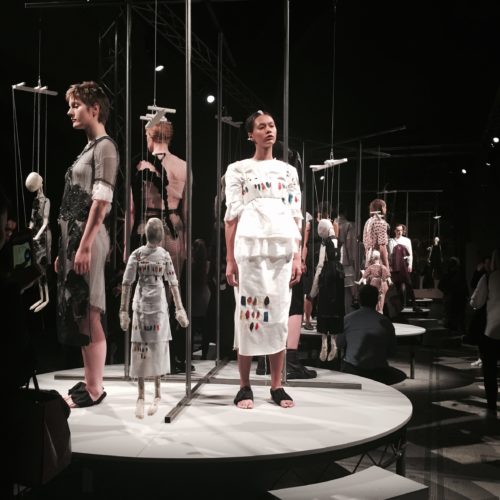
Last year, I wrote my BA dissertation about the portraits by American painter Kehinde Wiley. He is known for featuring African American subjects wearing contemporary street clothing in positions taken from the Western canon of portraiture. Typically, the subjects portrayed are not identifiable, but take on the poses of rulers of history, removed from their context and painted against lush, decorative backgrounds. After finishing his MFA at Yale University in 2001, Wiley began displaying his work in the early 2000s, bringing grandiose images of black and brown bodies dressed in street wear into white gallery and museum spaces. My project in regards to his oeuvre questioned the utility of this kind of portraiture, simultaneously hyper-real and mythologizing, in terms of the politics of representation of blackness in the visual sphere.
In these paintings, fashion associated with the visual culture of hip-hop becomes the uniform for Wiley’s subjects. They pose in baggy jeans, chains, puffer jackets, sports jerseys, and popular clothing brands, which are remarkable for two reasons: it is rather shocking to see these casually dressed, ‘cool’ black figures assuming the position of a Van Dyck portrait, but also because it was nearly unprecedented to see this kind of fashion hanging on the walls of a museum space. While European portraits of rulers certainly utilize a visual language of opulence and excess in dress, seeing contemporary ‘bling’ in such an image is rather unusual. Wiley has produced dozens of paintings like these, and critics have suggested that these images have become formulaic. Arguments that these works have a homogenizing, flattening effect over the representation of black life in America have substantial foundations in the repetition of similar iconographies. It is true that Wiley’s paintings are not a representative cross section. They saturate the art market with images of African Americans of a singular social milieu, and rely on stereotypes perpetuated in news media and popular culture of a young black man as a thug or a pompous rapper. On one hand, these paintings introduce a new figure and fashion into the canon of formal portraiture, but risk commodifying the image of ‘coolness’ further than it already has been.

Concurrently with the early years of Wiley’s career, an exhibit opened at the V&A called Black British Style (October 2004-January 2005) which displayed clothing, photographs, and other objects to explore the many notions of fashion in the legacy of the African diaspora, particularly on the African continent, in Jamaica, Britain, and the United States. It spanned many styles, geographies, and times, and blended artifact and image, and narrative and memory, to contribute to the building of an archive of African diasporic history in the legacy of slavery and erasure. Addressed within the exhibit was the fashion of hip-hop culture in contrast to African-inspired fashion in the West. Black Style, the book published in conjunction with the exhibit, notes that hip-hop subverts ‘establishment notions of racial difference through cutting-edge styles that throw back in the face of mainstream America its own stereotypes of inner-city black youth.’ At the same time, hip-hop dress has been continuously co-opted by mainstream white culture, and, like in Wiley’s paintings, can signal popular commodified fashion. However, the display of this style of dress within such an institution was rather groundbreaking. As curator Carol Tulloch noted, ‘It really was a landmark event for a major national institution like the V&A. One magazine wrote: “The fact that the V&A has batty riders on display is worth the £6 entry on its own.”’
Wiley’s portraits and the V&A’s exhibition entered the mainstream art world around the same time, bringing representations of hip-hop fashion into elitist white museum and gallery spaces. They worked in opposite visual languages – one of fantasy, myth, and the art historical canon, the other creating a documentarian notion of ‘truth’ – but attempted to work within the same system to call out stereotypes about the black body. Wiley’s paintings utilize the visual language of visibility; Black British Style the currency of archival information and objects. Although bringing representations of black style into these spaces requires a careful negotiation of celebration versus commodification and appropriation, the dressed black body became visible and present where it had not been before, and has opened a door to more diverse representations of dress and the bodies that occupy it.
References:
Lewis, Tim. “Carol Tulloch: ‘Dressing Well Is Almost Part of the DNA in the Black Community’.” The Guardian. March 06, 2016. Accessed December 01, 2018. https://www.theguardian.com/books/2016/mar/06/carol-tulloch-black-style-the-birth-of-cool-interview.
Tulloch, Carol. Black Style. London: V & A Publications, 2005.




















